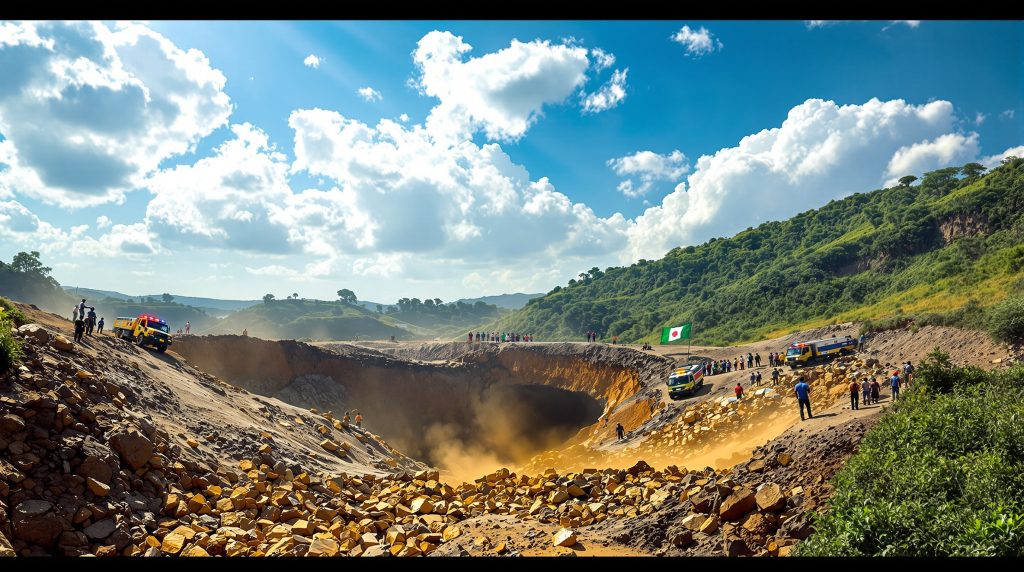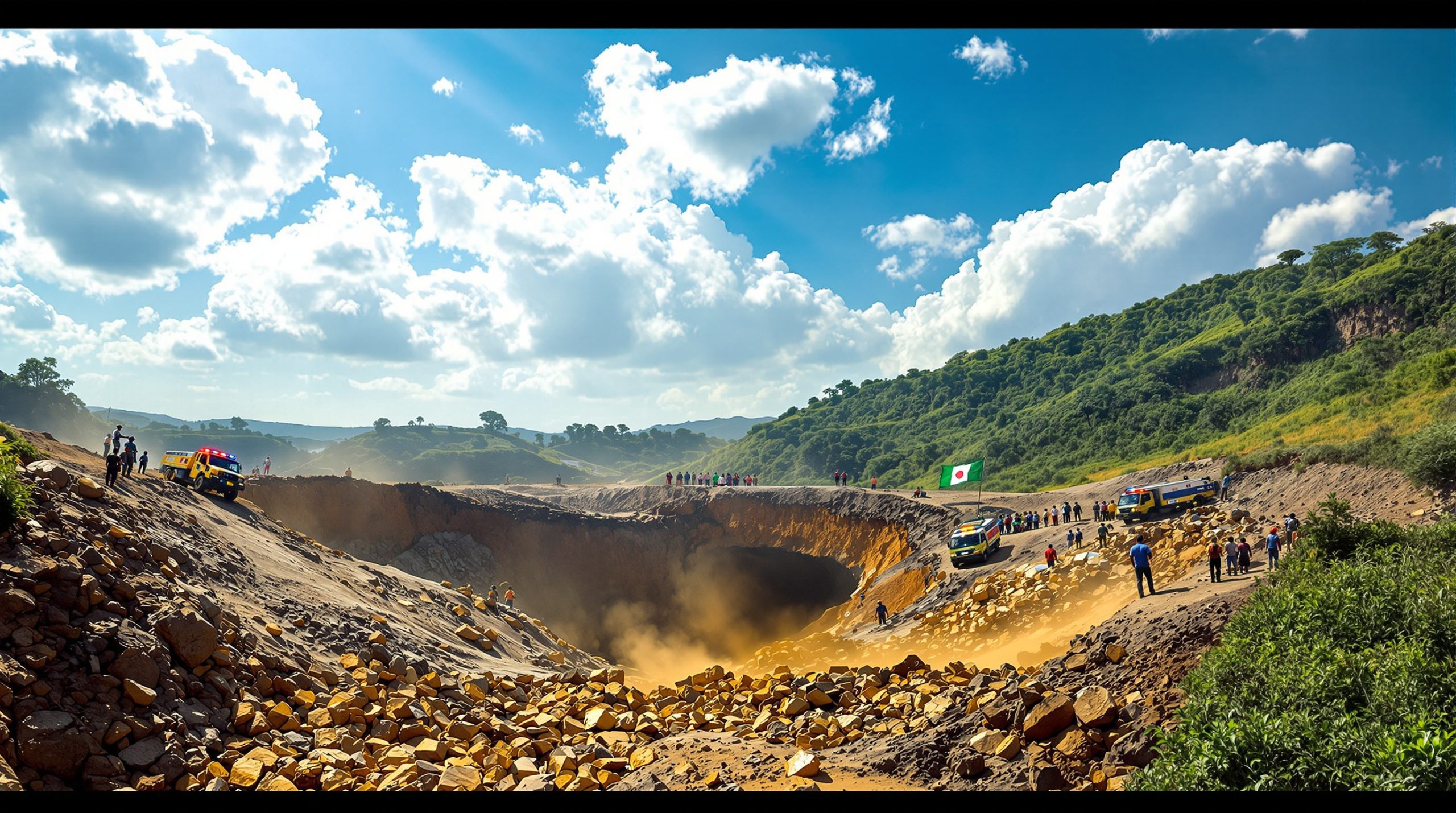Nigeria Gold Mine Tragedy: Over 100 Feared Dead in Zamfara State Collapse
In a devastating incident that has shocked Nigeria's mining community, a gold mine collapse in Nigeria has trapped approximately 100 artisanal miners underground, with rescue efforts continuing amid challenging conditions. This tragedy highlights the persistent dangers facing informal mining operations across northern Nigeria.
What Happened at the Kadauri Gold Mine?
The catastrophic collapse occurred on Thursday, September 25, 2025, at the Kadauri mining site in Maru local government area of Zamfara State. According to eyewitness accounts, the mining pit caved in while scores of artisanal miners were working underground, instantly trapping more than 100 individuals beneath tons of rock and soil.
By Friday, September 26, rescue teams had recovered at least 13 bodies from the rubble, with dozens more miners still trapped. The rescue operation began immediately after the collapse and continued through the night into Friday, with local residents joining professional rescuers in the desperate search for survivors.
"We are lucky to be rescued alive. Out of more than 100 people, only 15 of us were rescued," reported Isa Sani, a survivor currently receiving medical treatment for injuries sustained during the collapse.
The incident represents one of the deadliest mining industry evolution disasters in recent Nigerian history, affecting numerous families in a region already struggling with economic challenges and security concerns.
Why Do Mining Collapses Occur in Northern Nigeria?
Northern Nigeria's artisanal gold mining sector has long been plagued by safety issues stemming from a combination of geological, regulatory, and socioeconomic factors.
Geological Vulnerabilities
The gold-bearing regions of Zamfara State often feature unstable soil compositions that become particularly hazardous during mining operations. Without proper engineering assessments, miners frequently dig deep vertical shafts and horizontal tunnels that lack adequate structural support, creating conditions ripe for catastrophic failures.
These mining sites typically operate in areas with:
- High water tables that weaken soil cohesion
- Layered sedimentary deposits prone to shifting
- Natural fault lines that increase collapse risk
- Seasonal rainfall patterns that destabilize underground workings
Regulatory Challenges
Illegal mining operations flourish throughout Zamfara State, operating outside governmental oversight and mining safety preparation. This regulatory vacuum allows for dangerous mining practices to continue unchecked, including:
- Excessively deep excavations without proper shoring
- Inadequate ventilation systems in underground workings
- Absence of emergency escape routes or safety protocols
- Minimal to non-existent structural reinforcement
The Nigerian government has periodically attempted to crack down on illegal mining activities, but enforcement remains difficult in remote areas where mining represents one of few economic opportunities for local populations.
Armed Group Control
A significant contributing factor to the dangerous conditions in Zamfara's mining sector is the control exerted by armed groups over many gold fields. These criminal organizations:
- Prioritize rapid extraction over worker safety
- Prevent regulatory authorities from accessing mining sites
- Create environments where miners fear reporting unsafe conditions
- Force miners to work in increasingly dangerous conditions to maximize profits
This combination of factors has created a perfect storm for mining disasters, with the Kadauri collapse representing just the latest in a series of tragic incidents.
How Are Rescue Operations Conducted in Mine Collapses?
The ongoing rescue operation at the Kadauri mining site faces numerous challenges that complicate the already difficult task of reaching trapped miners.
Current Rescue Efforts
Rescue teams comprising local volunteers, mining association members, and some professional rescuers have been working continuously since the gold mine collapse in Nigeria occurred. Their efforts involve:
- Manual excavation of collapsed sections using basic tools
- Careful removal of debris to avoid secondary collapses
- Creation of temporary access tunnels to reach potential survival spaces
- Listening for sounds from trapped miners to guide excavation efforts
The rescue operation has been hampered by limited equipment and the inherent dangers of the unstable site. Muhammadu Isa of the Zamfara State miners association confirmed that some rescuers have themselves suffocated while attempting to dig out victims, highlighting the perilous nature of the rescue effort.
Technical Challenges in Mine Rescues
Mine rescue operations present unique challenges not encountered in other disaster scenarios:
- Unstable ground conditions that threaten rescuer safety
- Limited oxygen in underground spaces for both victims and rescuers
- Difficulty in bringing heavy equipment to remote mining locations
- Complex underground layouts that complicate navigation and access
The lack of specialized mining rescue equipment in many artisanal mining regions of Nigeria further complicates these efforts, often forcing rescuers to rely on manual methods that are both slower and more dangerous.
Is This an Isolated Incident or Part of a Pattern?
The Kadauri mine collapse, while devastating in its scale, represents part of a broader pattern of mining accidents that have plagued Nigeria's artisanal mining sector.
Recent Mining Disasters in Nigeria
Just days before the Zamfara collapse, another mining tragedy occurred in Niger State when a mine collapsed in the Shiroro district on September 23, 2025. Initial reports indicated at least one confirmed death with approximately 30 miners missing. The proximity of these two incidents in both timing and nature points to systemic issues affecting Nigeria's mining sector.
These recent incidents follow a troubling pattern that includes:
- Multiple collapses in Zamfara State over the past decade
- Recurring incidents during the rainy season when soil stability decreases
- Similar disasters in other northern states with artisanal mining operations
- A consistent lack of safety improvements despite repeated tragedies
Root Causes of Recurring Disasters
The persistence of these tragic events stems from several interconnected factors:
- Economic desperation driving workers to accept dangerous conditions
- Limited alternative livelihood options in mining communities
- Insufficient government capacity to monitor remote mining operations
- Lack of investment in safety training and equipment for artisanal miners
This pattern suggests that without significant interventions in how artisanal mining is regulated and supported, similar disasters will likely continue to occur.
What Makes Artisanal Gold Mining Particularly Dangerous?
Artisanal gold mining, by its very nature and operating context, contains inherent risks that make it one of the most dangerous occupations in regions like northern Nigeria.
Lack of Engineering Standards
Unlike commercial mining operations with engineers and safety specialists, artisanal mining typically proceeds without proper modern mine planning:
- Tunnels are excavated based on traditional knowledge rather than engineering principles
- Support structures are often minimal or improvised from available materials
- Depth limitations are rarely observed, with miners following gold veins regardless of risk
- Ventilation systems consist of rudimentary air holes that provide insufficient oxygen
The absence of engineering standards becomes particularly dangerous as mines grow deeper and more complex, with each expansion increasing collapse and suffocation risks.
Equipment and Training Deficiencies
Most artisanal miners work with basic hand tools and minimal protective equipment:
- Picks, shovels, and chisels for excavation instead of mechanical equipment
- Absence of hard hats, respiratory protection, or safety harnesses
- Kerosene lamps or flashlights instead of proper mining illumination
- Limited communication devices to call for help during emergencies
Compounding these equipment limitations is the general lack of formal safety training:
- Miners learn through apprenticeship rather than structured safety education
- Emergency response procedures are rarely practiced or established
- Risk assessment skills are underdeveloped or absent
- First aid and rescue knowledge is minimal among most mining teams
These deficiencies create a working environment where accidents not only occur more frequently but also tend to have more severe consequences when they do happen.
How Does This Incident Compare to Other Global Mining Disasters?
While comprehensive casualty figures from the Kadauri collapse remain uncertain, the estimated toll places it among significant mining disasters globally, particularly within the artisanal mining context.
Scale and Impact Assessment
With over 100 miners feared dead, the Zamfara collapse represents:
- One of the deadliest mining accidents in Nigeria in recent years
- A significant disaster even by global artisanal mining standards
- A devastating blow to local communities that depend on mining income
- A stark illustration of the human cost of inadequate mining regulations
The true impact extends beyond the immediate casualties to affect hundreds of family members who have lost breadwinners, creating ripple effects throughout the regional economy.
Safety Standards Gap
The incident highlights the vast disparity in safety standards between regulated commercial mining operations and artisanal mining:
- Modern commercial mines implement extensive ground support systems and monitoring
- Professional mining operations conduct regular geotechnical assessments
- Commercial mines typically have dedicated safety teams and emergency response protocols
- Large-scale operations invest in ventilation systems and gas monitoring equipment
This standards gap is particularly pronounced in regions like northern Nigeria, where artisanal mining proceeds with minimal oversight or support from regulatory authorities.
What Economic Factors Drive Dangerous Mining Practices?
Understanding the persistence of dangerous mining practices requires examining the economic context that makes artisanal gold mining both necessary and attractive despite its risks.
Gold Mining and Local Livelihoods
For many communities in northern Nigeria, artisanal gold mining represents one of few available pathways to economic stability:
- Mining can provide income 3-5 times higher than agricultural alternatives
- Immediate cash flow versus seasonal agricultural income
- Low barriers to entry requiring minimal startup capital
- Community-based operations that support extended family networks
These economic realities create powerful incentives for individuals to accept mining risks, particularly in regions with limited alternative employment options.
Market Pressures and Resource Management
Global gold prices and market dynamics influence safety practices at the local level:
- High gold prices encourage deeper and more dangerous mining to access richer deposits
- Competition between mining groups drives faster, less careful extraction methods
- Limited capital prevents investment in safety infrastructure and equipment
- Pressure to maximize short-term yields over sustainable, safer mining approaches
The informal nature of artisanal mining also means operators cannot access insurance, financing for safety equipment, or technical support that might mitigate risks.
What Responses Are Needed to Prevent Future Tragedies?
Preventing future mining disasters in Nigeria will require a comprehensive approach addressing regulatory, technical, economic, and social aspects of artisanal mining.
Regulatory and Enforcement Recommendations
Effective policy responses must balance safety requirements with practical implementation in remote regions:
- Development of simplified safety standards specifically for artisanal mining
- Creation of local mining safety committees with authority to inspect operations
- Licensing systems that include basic safety training requirements
- Incentives for compliance rather than purely punitive enforcement approaches
These regulatory approaches must address the reality that many mining operations exist in areas with limited government presence, requiring community-based enforcement mechanisms.
Technical and Training Solutions
Practical interventions to improve mining safety could include:
- Distribution of basic mine support materials and safety equipment
- Mobile training programs bringing safety education to remote mining communities
- Development and demonstration of simple, affordable shoring techniques
- Community-based rescue teams equipped with essential extraction tools
These technical interventions should focus on low-cost, high-impact improvements that recognize the economic constraints of artisanal mining communities.
Formalization and Support Programs
Longer-term solutions require addressing the informal nature of artisanal mining:
- Pathways to formalization that recognize existing mining rights
- Cooperative structures that can pool resources for safety improvements
- Access to microfinance for safety equipment and infrastructure
- Technical partnerships with larger mining companies for knowledge transfer
By bringing artisanal mining into regulated frameworks while providing support rather than just enforcement, safety improvements become more sustainable.
What Are the Broader Implications for Nigeria's Mining Sector?
The Kadauri disaster carries significant implications for Nigeria's broader ambitions to develop its mining sector as a major economic pillar beyond oil and gas.
Impact on Mining Industry Development
Recurring disasters threaten Nigeria's efforts to attract investment in its mining sector:
- International mining companies may hesitate to enter markets with negative safety perceptions
- Financing becomes more difficult to secure for mining ventures in high-risk regions
- Insurance costs increase, raising operating expenses for legitimate operations
- Recruitment of skilled personnel becomes more challenging
These factors can slow the development of Nigeria's mining potential at a time when the country seeks to diversify its economy beyond petroleum.
Environmental and Social Consequences
Beyond immediate human tragedy, mining collapses create lasting environmental and social impacts:
- Abandoned collapse sites often become environmental hazards
- Water contamination from disturbed mining areas affects broader communities
- Loss of breadwinners creates cycles of poverty in mining-dependent regions
- Psychological trauma affects survivors, families, and entire communities
Addressing these broader implications requires viewing mining safety not just as a technical issue but as an integral component of sustainable development policy. Furthermore, implementing proper mine reclamation importance practices is essential for long-term sustainability.
FAQ: Nigeria's Gold Mine Collapse
How common are mining accidents in Nigeria?
Mining accidents occur with concerning frequency across Nigeria's artisanal mining regions. While comprehensive statistics are limited due to the informal nature of many operations, localized collapses, suffocation incidents, and other accidents are reported regularly. Northern states with significant artisanal mining activities like Zamfara, Niger, and Kaduna experience multiple incidents annually, though many smaller accidents may go unreported.
What safety measures could prevent such collapses?
Effective prevention measures include proper timber shoring and roof support systems, limiting tunnel depth and span, implementing regular structural inspections, ensuring adequate ventilation systems, establishing maximum occupancy limits for underground workings, and providing basic training in hazard recognition. Even simple improvements like systematic testing of hanging walls before work begins could significantly reduce collapse risks.
Are there legitimate gold mining operations in Nigeria?
Yes, Nigeria has both legitimate commercial gold mining operations and widespread artisanal mining activities. Several international and domestic mining companies operate formal, licensed gold mines with significantly better safety records due to adherence to international mining standards. The Federal Ministry of Mines and Steel Development has been working to attract more formal investment while attempting to regulate artisanal operations.
How does the government regulate mining in Nigeria?
Mining regulation falls under the Ministry of Mines and Steel Development, which issues permits and licenses through the Nigerian Mining Cadastre Office. The 2007 Nigerian Minerals and Mining Act provides the legal framework for mining activities, including safety provisions. However, enforcement challenges, particularly in remote areas and regions with security concerns, have limited the effectiveness of these regulations for artisanal mining operations.
What happens to families who lose relatives in mining accidents?
Families who lose breadwinners in mining accidents often face severe economic hardship, as compensation systems are typically non-existent in informal mining operations. Communities generally provide immediate support, but the long-term financial impact on families can be devastating. Unlike formal employment sectors, artisanal mining rarely offers life insurance or death benefits, leaving families to cope with both emotional and financial consequences of their loss. The psychological impact often requires mining mental health strategies to help communities recover from such tragedies.
Further Exploration
For those interested in learning more about mining safety challenges in West Africa, additional educational resources are available through various international mining safety organizations and academic institutions that specialize in artisanal mining practices. Understanding these complex issues requires examining the intersection of economic development, resource governance, technical safety standards, and community resilience in mining-dependent regions.
Want to Invest in the Next Major Mineral Discovery?
Discover why historic ASX mineral discoveries can generate substantial returns with Discovery Alert's proprietary Discovery IQ model, transforming complex mineral data into actionable investment opportunities. Explore real-world examples of exceptional market outcomes by visiting the Discovery Alert discoveries page and begin your 30-day free trial today to position yourself ahead of the market.




